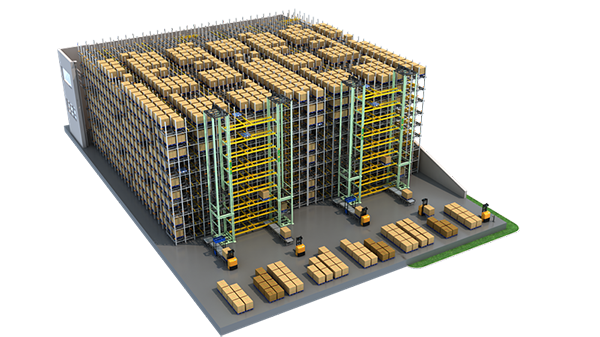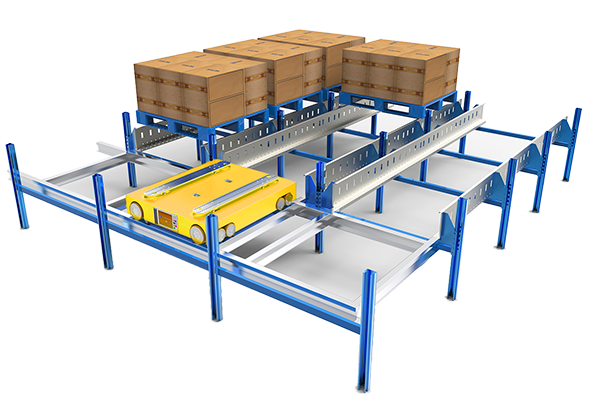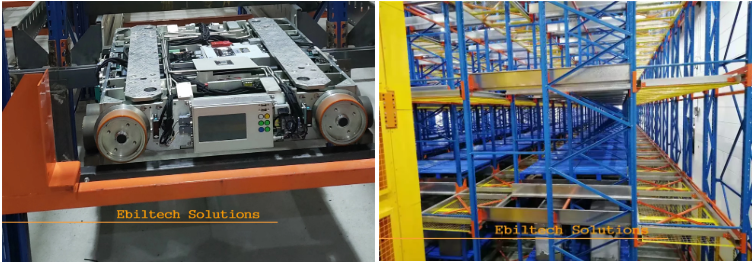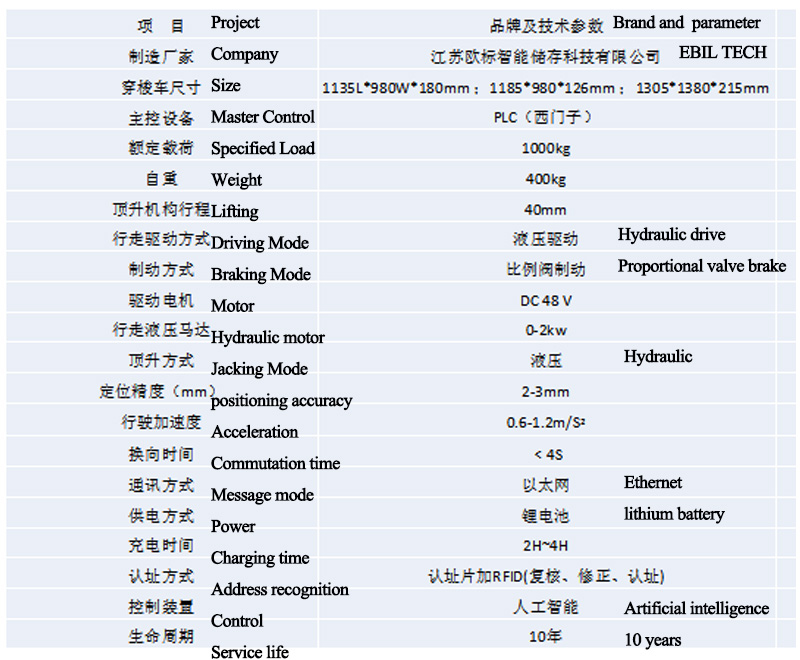
Four-way Shuttle system


Core functions of four-way shuttle car:
l Advancement: The four-way shuttle is mainly used for the automatic handling and conveying of pallet goods in the warehouse. It is an intelligent storage equipment integrating intelligent control, automatic handling, unmanned guidance and other functions. The EBIL TECH four-way shuttle can cooperate with the hoist to complete the six dimensions of front and back, left and right, and up and down operations.
l Flexibility: The four-way vehicle can automatically inventory and pick up, intelligent leveling, automatic climbing, automatic lane and layer change, and can also reach any position of the warehouse according to customer needs, so that the warehouse space utilization rate can be maximized. The 4 way shuttle racking system is suitable for special-shaped warehouses and can be matched with hoists to reach any height required by customers
l Practicability: The height of the four-way shuttle cart is small, and the distance between the upper surface of the trolley's track and the ground is only 300mm, which can efficiently use the warehouse space.
l Reliability: All equipment products and control components in the 4 way shuttle car is very reliable and sophisticated. The control system adopts simple and stable control elements, uses specific algorithms, and combines the simple and solid mechanical structure of the trolley to achieve the purpose of stable, accurate, fast and reliable operation of the shuttle car.
Advantages of four-way shuttle racking system:
l The four-way shuttle system scheme can make full use of the warehouse space and have more pallet positions.
l The four-way shuttle system solution has the function of being able to randomly out of warehouse, so it can avoid warehouse shifting and shifting, and the efficiency can be maximized;
l The operating efficiency of the four-way shuttle is flexible and controllable. If there is demand for efficient growth, you only need to increase the number of four-way shuttle car and the workload of the project transformation will be very small, or even zero;
l The project investment is low, and the quantity of equipment is equipped according to the efficiency of the customer's demand. While meeting the customer's demand for efficiency, the cost investment can be reduced;
l The design of the adjustable upright height makes it simpler of rack installation, so the rack installation accuracy will be higher.
Application scenario of EBIL TECH 4 way shuttle:
The four-way shuttle car can be used in intelligent intensive raw material warehouse, semi-finished product warehouse, and finished product warehouse;
The four-way shuttle car can be used for the central warehouse of logistics transshipment;
The four-way shuttle car can be used in the workshop line side warehouse of the smart factory;
Four-way shuttle car can be used in fruit and vegetable storage and cold storage;
Four-way shuttle car can be used in unmanned black light warehouses.

Technical Parameters

Four-way shuttle for cold storage
The four-way shuttle for cold storage is a special handling and transportation intelligent storage equipment developed by EBIL TECH for cold warehouse. It can safely and stably store and distribute goods in the low temperature.
Advcantages of four-way shuttle for cold storage:
Using low-temperature batteries to ensure normal driving in the cold storage;
Laminating the circuit board;
The hydraulic system uses low-temperature hydraulic oil to ensure that the hydraulic pressure can run normally at low temperatures
Using scenarios of cold storage four-way vehicles:
Cold Chain Logistics
Fresh Food E-commerce
Pharmaceutical Raw Materials
Food Warehouse
Main parts of four-way shuttle car
The device selection strictly follows the "advanced, reliable, mature, and easy-to-use" standard for selection, which provides a guarantee for the design of the scheme. The main component selection of this electric control system scheme is as follows:

Introduction of Design Scheme
Driven by DC motor, battery: 48V, 60AH;
Reversing and lifting of pallets adopt hydraulic method;
The control is completed by PLC.
Main control module
PLC (Siemens)
Advantages of Siemens PLC:
Famous brand, extremely high reliability;
Rich built-in integrated functions;
Rich expansion modules;
Strong communication capabilities.
Reasons for choosing PLC control:
Stability: When there is no need to process large amounts of data, PLC is more stable, especially for long-term applications;
Concise: PLC can directly control the driver and other components, and the industrial computer needs to add an unstable CAN module;
PLC has strong versatility and high penetration rate, and customers can operate the application through simple training.
Underlying logic algorithm
Pulse plus reading (remaining displacement):
Frid absolute addressing review, correction, address recognition.
Driving
Running and identification of the 4 way shuttle car
As shown in the figure, the driving process of the shuttle car from the original address (2, L) to the target address (7, AQ) will include driving and reversing actions. When the car travels from (2, L) to the first reversing point (7, L), a certain amount of pulse will be given.
Then in the process of driving, scan the address recognition chip on the cargo location continuously to update the pulse amount, and the RFID on the address recognition chip will verify whether the read address recognition chip is correct, and finally check the reversing position.
After the shuttle car arrives at (7, L), the reflective photoelectric on the trolley will fine-tune and correct the position, change direction after reaching the requirements, and then drive to (7, AQ) in the same way.

Reversing of the 4 way shuttle car
When the shuttle car reaches the reversing point, there will be two photoelectric devices to illuminate the correction film on the right. The correction length is 10.3CM, and the distance between the photoelectricity is 10CM. When one side of the photoelectric illuminates the correction film and the other side does not, the shuttle car will move to one side until both are illuminated, and then start the reversing procedure.
Machinery (accessories)
Standardized shuttle car body: 45# steel car body made of precise laser cutting, the cylinder body thickness reaches 22mm, and the loading capacity reaches more than 2 tons; laser cutting, high precision;
Using hydraulic jacking; heavy load; simple structure (solenoid valve control oil cylinder);
The design service life of the above components is 10 years;
Accurate measurement: laser technology is used to measure the length, width, height and diagonal of the car body, and the measurement accuracy is within 0.1mm.
Mechanical (track fit)
The wheel adopts a structure similar to that of a train wheel with a wheel edge and closely fits the track. The distance between the wheel edge and the track is only 1mm, which effectively solves the problem of driving deviation.
Hardware, software (the nerve center of the shuttle car)
Core of the shuttle : the shuttle use stable Siemens PLC as the main control module, plus specific logic algorithms to ensure error-free judgment and operation;
Electricity
Adopt the world's top brands Siemens, Schneider, NSK, strong stability and more reliable
Test
In order to check the quality and give a perfect shuttle car to the project site, the shuttle car must be tested in the field for 10 to 15 days. The test content mainly includes:
Fatigue test: Each 4 way shuttle car runs continuously in the test area for more than 8 hours a day.
Alternate operation of load and no-load: alternate operation of load and no-load, in line with general project scenarios.
Mechanical testing: testing of chain tension, gear bite, etc.
Electrical test: the stability of the trolley, heat generation and other tests.
Software testing: testing of car acceleration and deceleration, driving accuracy, signal acceptance status, etc.
 86-25-5279 6106
86-25-5279 6106
 Contact
Contact




 Download
Download